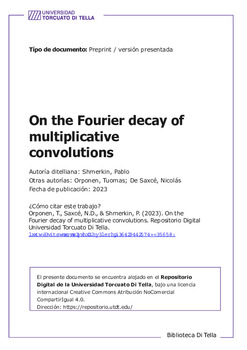| dc.rights.license | https://creativecommons.org/licenses/by-sa/2.5/ar/ | es_AR |
| dc.contributor.author | Shmerkin, Pablo | es_AR |
| dc.contributor.author | Orponen, Tuomas | es_AR |
| dc.contributor.author | De Saxcé, Nicolás | es_AR |
| dc.date.accessioned | 2023-11-21T21:20:35Z | |
| dc.date.available | 2023-11-21T21:20:35Z | |
| dc.date.issued | 2023 | |
| dc.identifier.uri | https://repositorio.utdt.edu/handle/20.500.13098/12146 | |
| dc.description.abstract | We prove the following. Let $\mu_{1},\ldots,\mu_{n}$ be Borel probability measures on $[-1,1]$ such that $\mu_{j}$ has finite $s_j$-energy for certain indices $s_{j} \in (0,1]$ with $s_{1} + \ldots + s_{n}>1$. Then, the multiplicative convolution of the measures $\mu_{1},\ldots,\mu_{n}$ has power Fourier decay: there exists a constant $\tau = \tau(s_{1},\ldots,s_{n})>0$ such that $$ \left| \int e^{-2\pi i \xi \cdot x_{1}\cdots x_{n}} \, d\mu_{1}(x_{1}) \cdots \, d\mu_{n}(x_{n}) \right| \leq |\xi|^{-\tau}$$ for sufficiently large $|\xi|$. This verifies a suggestion of Bourgain from 2010. | es_AR |
| dc.format.extent | 14 p. | es_AR |
| dc.format.medium | application/pdf | es_AR |
| dc.language | eng | es_AR |
| dc.publisher | Universidad Torcuato Di Tella | es_AR |
| dc.rights | info:eu-repo/semantics/openAccess | es_AR |
| dc.subject | Fourier decay | es_AR |
| dc.subject | Matemáticas | es_AR |
| dc.subject | Mathematics | es_AR |
| dc.subject | Borel measure | es_AR |
| dc.subject | Fractal Measures | es_AR |
| dc.subject | Bourgain’s Theorem | es_AR |
| dc.subject | Classical Analysis and ODEs | es_AR |
| dc.title | On the Fourier decay of multiplicative convolutions | es_AR |
| dc.type | info:eu-repo/semantics/preprint | es_AR |
| dc.type.version | info:eu-repo/semantics/submittedVersion | es_AR |

